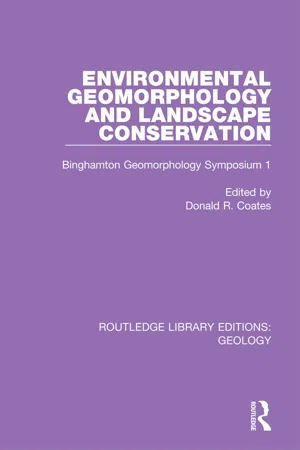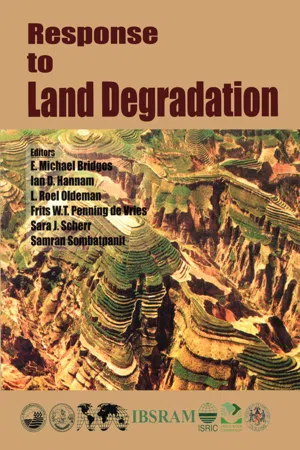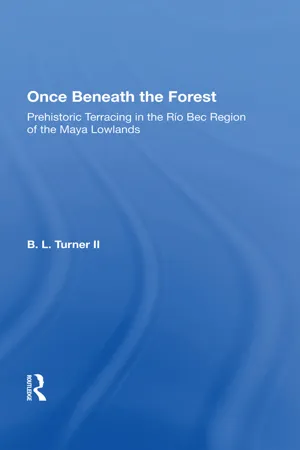Geography
Terrace Farming
Terrace farming is a method of farming on steep slopes or hillsides that involves creating flat areas, or terraces, to plant crops. This technique helps to prevent soil erosion and allows for efficient water management in areas with limited arable land. Terrace farming has been practiced for centuries in various parts of the world, including Asia, South America, and Africa.
Written by Perlego with AI-assistance
Related key terms
Related key terms
1 of 4
Related key terms
1 of 3
5 Key excerpts on "Terrace Farming"
- eBook - ePub
Fragile Lands of Latin America
Strategies For Sustainable Development
- John O. Browder(Author)
- 2019(Publication Date)
- Routledge(Publisher)
What I call the promise of agricultural terraces emerges from their ecological virtues: moisture-retentive, erosion-proof soils of good tilth; advantageous micro-climatic features; and efficient systems of gravity irrigation. Terrace agriculture is demonstrably sustainable: many terraces in the Colca Valley appear to have been in constant use since the Inca period. Terraces counteract erosive forces that make the highlands a particularly fragile environment. Rainfall is highly seasonal in the Andean region, and on most slopes, erosion is not slow and continuous but occurs rapidly during heavy storms and off-year bursts of rains (Williams et al., 1986:46–47). While 58 percent of the region’s soils experience only light to moderate rates of erosion and appear remarkably intact despite centuries of farming (due, perhaps, to sectorial fallowing systems), 16 percent suffer serious erosion as evidenced by gullying and earthslides (Alfaro, 1986:56–57). As agriculture intensifies and fallowing times decrease due to expanding populations and commercial farming (Mayer, 1979; Orlove and Godoy, 1986), erosion accelerates accordingly. Programs to encourage terracing could fight erosion along two fronts; (1) terracing some existing lands in cultivation may halt or drastically reduce soil erosion; and (2) restoring terraces or building new ones to expand the farming frontier may take pressure off unterraced fields which may be fallowed for longer periods.The notion of fragility also applies to the enterprise of agriculture in the Andes where success is in constant jeopardy not only from erosive forces, but also from frequent droughts, floods, hailstorms, and frosts. The risks to agriculture are great, and yields may fluctuate greatly from year to year because of environmental disturbances. This translates into social and economic fragility caused by the unpredictable nature of highland climates. Failure to harvest sufficient amounts of food, either for consumption or for sale, forces people to abandon farming and seek employment elsewhere. For farmers, reducing agricultural risk is a basic imperative, permitting them not only to survive, but also to safely experiment with new crops and pursue commercial production. Terracing, as we shall see, reduces the risks of farming and therefore appears to be particularly appropriate for small farmers whose livelihoods and futures are often at risk to begin with.Nonetheless, reestablishing the practice of terracing is problematic and demands working within contemporary socioeconomic contexts. Above all, it demands working within the local contexts of Andean communities where abandoned and future sites may be located. The extent to which terrace construction and reconstruction is consonant with household and community economic goals, local irrigation capacities, and land tenure patterns may in large measure determine the ultimate success of new terrace agriculture. - eBook - ePub
Environmental Geomorphology and Landscape Conservation
Binghamton Geomorphology Symposium 1
- Donald R. Coates(Author)
- 2020(Publication Date)
- Routledge(Publisher)
The instructions given herein for the selection and design of terrace systems are based upon the results of surveys, observation, and a study of terraced fields in the best-terraced sections in this country and it is believed that if they are followed carefully a great increase in the efficiency of terrace systems will result and that much better opportunity will be afforded to observe the results with a view to further improving the practice of terracing. At the same time a close study of local conditions–particularly of soil—should be made which no doubt will afford more definite information for improving further the design of a terrace system adapted to a particular locality.Since the primary purpose of terracing is to hold the soil of the farm in place and thereby both maintain its fertility and render possible an increase of fertility by proper farming methods, all of the benefits, such as greater yields and land values, which result from the preservation and increased fertility of the soil may be attributed direct to the practice of terracing. In short, the terracing of farm lands saves the soils the most substantial and valuable asset of the country.〇1 Bulletin 17, North Carolina Geological and Economic Survey, p. 21.Note .—This bulletin treats of terracing as a means of preventing erosion of hillside land. It describes the different types of terraces and points out the applicability of each to the various kinds of soil and topography. It discusses the principles of terrace design. While the investigations upon which the recommendations are based were made in the Southern States, the information is applicable generally to any State in the humid section.71775°—Bull. 512—17——12 For a more extended discussion of the translocation of soils, see U. S. Dept. Agr. Bui. 180, by R. O. E. Davis.3 Soil Report N. 3, Illinois Agricultural Experiment Station, p.16.4 - eBook - ePub
- E M Bridges(Author)
- 2019(Publication Date)
- CRC Press(Publisher)
well-maintained. Terraces, to be effective, must be properly constructed and continuously maintained. Otherwise they can turn into a liability. There are other reasons also why constructing terraces may not always be the best bet for conservation.Figure 1.Ancient terraces at Machu Picchu, Peru.Form and function
Agricultural terracing is the creation of flat (or relatively flat) strips of land to allow cultivation of slopes where this would have been difficult or impossible. Terraces permit better management of soil and water, improve access to land, and facilitate farm operations by hand or machine. By definition, a terrace is a unit consisting of a structure across the slope (a riser, bund, wall etc.) that supports above it a terrace bed (which may be level, sloping backwards, forwards and/or laterally). A bench terrace has a bed with a gradient of less than 3° in any direction, and a bed width of usually 10 m or less.Whatever their original design or origin, terraces tend to be dynamic; they change over time. In the case of the ‘fanya juu’ terrace4 in East Africa, erosion and cultivation between earth bunds combined with raising the height of the bund leads to a gradual levelling of the terrace bed. Another interesting dynamic is that of ‘default terracing’ where a de facto riser is formed at the top of a plot as a result of the soil displacement effect of hoeing or mechanical cultivation (tillage erosion); a terrace is thus created. Terrace units undergo various internal micro-erosion and sedimentation processes, which change their shape, and sometimes indeed their mode of function, over time. The textbook image of orderly, scientifically designed, level bench terraces with stone-faced risers is far less common than the myriad forms of intermediate and dynamic structures found in reality. Table 1 - eBook - ePub
Once Beneath The Forest
Prehistoric Terracing In The Rio Bec Region Of The Maya Lowlands
- Bl Turner Ii(Author)
- 2019(Publication Date)
- Routledge(Publisher)
5Río Bec Slope and Maya Agriculture: Interpretations and PerspectivesFrequency/Intensity of Río Bec Terrace Agriculture
The vestiges of terraced hillsides throughout the Río Bec region are evidence that ancient farmers altered the surface geometry of slopes for some purpose. It is proposed that the immediate functions of the terraces were to manipulate a number of mechanical and geochemical processes associated with the impact on soils of continuous cultivation or of systems in which time in crop exceeded the time in fallow. Presumably, the use of “fallow-frequent” methods of cultivation would not exacerbate the physical processes on soils to the point of necessitating terrace use, and farmers would have been reluctant to incur the cost of construction if the benefits were not either increased output or sustained output in the face of environmental change.Several problems are related to this line of reasoning. First, environmental impacts on slope cultivation in the area are not precisely known. As attested by the previous discussion, evidence from other areas of the Maya lowlands with comparable habitats is sparse. That which is available seems to support the arguments concerning cropping impact on soil loss, soil nutrient loss, and soil moisture problems. Ideally experimental cultivation/impact data from Río Bec slopes are needed to provide precise evidence. These data, however, would only establish the parameters of the variables involved and the possible levels of cultivation that would have necessitated terracing in the past. The levels of output or frequency of cultivation actually achieved would remain speculative.The second problem is composed of two related parts--the establishment of relationships between (1) agrotechnologies, and cultivation frequency and output, and/or (2) agricultural inputs and outputs. Both relationships are related to the nature of farming behavior and the appropriate explanatory mix of general tendencies with site specific variables. Here the prehistorian must rely on comparative evidence which can only provide relative answers or provide the parameters in which the use of the agrotechnology is expected. Nevertheless, these approaches provide the best means of providing interpretations of the Río Bec terraces and most other agricultural relics.1 - eBook - ePub
Sustainable Land Management in Asia
Introducing the Landscape Approach
- William Critchley, Frank Radstake(Authors)
- 2017(Publication Date)
- Asian Development Bank(Publisher)
Critchley et al. 2001 ; WOCAT 2007).The ancient Banaue Rice Terraces in the Philippines have become a site of agro-ecotourism.Traditional stone-faced bench terraces for rainfed crop production are a common site in India’s Himalayan foothills.Terraces are a clear example of a conservation technology evolving independently on different continents. Their ubiquitous occurrence dispels the myth that sustainable land management practices always have to be taught from outside: many (though not all) of the best practices have been devised by innovative farmers throughout the world, and built without technical support or financial incentives. While bench terrace construction was a common feature of conservation programs last century, with the exception of massive programs in the PRC (see WOCAT 2007; PRC-GEF and LADA 2008; and World Bank 2010 for an extraordinary achievement on the Loess plateau), the current emphasis has turned toward low-cost contour vegetative barriers. Thus, terrace construction on steep slopes is being increasingly consigned to history and ecotourism because of costs and, in some places, increasingly stringent legislation regarding cultivation of unstable steep slopes.The best known and most widespread form of terraces in Asia are bench terraces. These can be defined as terraces having a bed (the planting area) with a gradient of 3 degrees or less in any direction (otherwise, they are better described as “forward-sloping” or “back-sloping” terraces), and a bed width of usually 10 meters or less (Critchley et al. 2001 ). They are generally continuous down a hillside, with the top of a given terrace riser elevated slightly above the bed of the terrace upslope. The terrace riser, or terrace wall, may be made of stone (almost invariably so, where loose stone is available), or earth. Earth risers are often protected by grass, especially fodder grass, which can be cut for stall-fed cattle or goats, thus making productive use of the banks (risers) separating cropping strips. Conversely, unprotected earth risers, being steep and exposed, can constitute a significant source of sediment flowing out of the landscape themselves (Critchley et al. 2001
Index pages curate the most relevant extracts from our library of academic textbooks. They’ve been created using an in-house natural language model (NLM), each adding context and meaning to key research topics.
Explore more topic indexes
Explore more topic indexes
1 of 6
Explore more topic indexes
1 of 4




